Utuado, Puerto Rico
Utuado (Spanish pronunciation: [uˈtwaðo]) is a municipality of Puerto Rico located in the central mountainous region of the island known as La Cordillera Central. It is located north of Adjuntas and Ponce; south of Hatillo and Arecibo; east of Lares; and west of Ciales and Jayuya. In land area it is the third-largest municipality in Puerto Rico (after Arecibo and Ponce). According to the 2000 US Census, the city has a population of 35,336 spread over 24 wards and Utuado Pueblo (the downtown area and the administrative center of the city). The name Utuado derives from the Taíno word Otoao, meaning "between mountains". The municipality is known as La Ciudad del Viví meaning "The City of the Viví", derived from the Viví River which runs through Utuado: one river branch comes from Adjuntas and the other from Jayuya. These two rivers then meet near the Fernando L. Ribas Dominicci Avenue and continue the journey to Lago Dos Bocas.
Utuado Municipio de Utuado | |
|---|---|
Town and Municipality | |
 View of Utuado Pueblo from Sabana Grande barrio | |
 Flag | |
| Nicknames: "La Ciudad del Viví", "Los Montañeses" | |
| Anthem: "Valle Bendito El De Mi Otoao" | |
 Map of Puerto Rico highlighting Utuado Municipality | |
| Coordinates: 18°15′56″N 66°42′02″W | |
| Commonwealth | |
| Founded | 1739 |
| Wards | |
| Government | |
| • Mayor | Ernesto Irizarry Salvá (PPD) |
| • Senatorial dist. | 5 - Ponce |
| Area | |
| • Total | 114.99 sq mi (297.83 km2) |
| • Land | 113.45 sq mi (293.83 km2) |
| Population (2010) | |
| • Total | 33,149 |
| • Density | 290/sq mi (110/km2) |
| Demonym(s) | Utuadeños |
| Time zone | UTC−4 (AST) |
| ZIP Codes | 00641, 00611 |
| Area code(s) | 787/939 |
| Major routes | |
Utuado is the main city of the Utuado micropolitan statistical area and is part of the San Juan-Caguas-Fajardo Combined Statistical Area.
History
Utuado was founded October 12, 1739, by Sebastian de Morfi, on behalf of 60 families from Arecibo. It was the first town established in the interior, mountainous region of the island known as La Cordillera Central and the 11th oldest established municipality in Puerto Rico, following San Juan, San Germán, Coamo, Arecibo, Aguada, Loiza, Ponce, Añasco, Guayama and Manatí.
Columbus's arrival
At the time of the Spanish initial occupation of the island on November 19, 1493, by Christopher Columbus, Puerto Rico was inhabited by the Taíno Indians. The Taínos were a culturally developed society with a universal language, a developed agricultural system, and a social organization based on caciques or chieftains. The Utuado area was ruled over by cacique Guarionex. In Caguana barrio, the Taínos built a series of courts or bateyes, Caguana Ceremonial Ball Courts Site, that is considered the best example of Taino engineering in the West Indies.
Early history: XVI–XVIII
In his work El Dorado Borincano, La economia de la conquista 1510–1550, Jalil Sued Badillo gives a detailed account of the economic state of Puerto Rico during the first decades after the discovery and mentions the importance of the Otoao region. From 1510 through 1513, the island witnessed a Taíno rebellion as a result of harsh and inhumane treatment by the Spanish settlers. During the process of pacification many Spaniards settled in the area now occupied by the municipality of Utuado and set up farms (haciendas), initially on behalf of the Spanish government (Hacienda Real Dos), to provide food to the Indian slaves working the gold mines and the Spanish colonists in the area. One of the first settlers in the Otoao region in 1512 was Antonio Sedeño, the island's bookkeeper. His farm's main crop was yuca. His farm was sold in 1519 to Blas de Villasante, the island's treasurer, for 525 gold pesos.
Areas in the Utuado region that were exploited for gold include Salto Arriba barrio, initially, then later in the 1530s Caguana barrio and Don Alonso barrio. In the 1530s, landowners in the Don Alonso area petitioned the Spanish Crown allow for the establishment of a town in the area but it was never granted.
Once the gold mining era ends toward the end of the 16th century, very little is known about the Utuado region until the early 18th century. According to the Puerto Rican historian Fernando Picó, the few documents that exist indicate the area was mostly unpopulated and densely forested. On the other hand, he states that Utuado is the municipality with the most caves, that most likely served as dwellings for Indians or runaway slaves.

The agreement to establish the town of Utuado by the 60 families of Arecibo states they purchased the Hato de Otoao for 569 pesos and 5 reales from owners Manuel Natal and Felipa Román. It also states their desire to choose where on the land the town center would be located, which indicates the area was not populated yet.
During his visit to the island in 1771, Fray Iñigo Abbad y Lasierra states the principal economic activity in the Utuado region was cattle raising, horses and mules. He mentions a small amount of agricultural activity existed but the population only produced enough tobacco and coffee for their own consumption.
During the late 18th and early 19th centuries, Utuado's population continued to grow as coffee gained in importance and growers saw the need for high altitudes and mountainous terrain to produce the best coffee beans. People not only migrated from the Puerto Rican coastal towns but also from Ireland (Founder Sebastian de Morfi = Sebastian Murphy), Canary Islands and the Balearic Islands of Majorca and Menorca, all seeking the riches that coffee had to offer.
Utuado was the first municipality to elect officials after Spain ceded Puerto Rico to the United States.[1]
Golden era of coffee – "black gold"
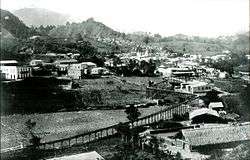
During the late 19th century Utuado experienced an explosive economic growth centered around the cultivation of coffee, also known at the time as oro negro or "black gold". By the 1890s Utuado was the largest producer of coffee in Puerto Rico and the second municipality (after Ponce) with the largest population. It produced a rich social life for many of its citizens and a casino and theatre were established in the town. The progress of the town was so evident that the regent Queen of Spain, María Cristina, honored the town with the title of Ciudad (City) on August 20, 1894.[2] In 1896 or 1897 Utuado was the first city in Puerto Rico with a public electric lighting system powered by a hydraulic turbine power plant,[3][4] and in that same year mayor Juan Casellas planned a train system to unite Utuado with Arecibo. By 1899 this golden era ended due to two events: the United States occupation of the island in 1898, which made sugar the new crop of importance instead of coffee (Utuado's mountainous landscape was not ideal for growing sugarcane, making it impossible for it to compete in the sugar industry), and Hurricane San Ciriaco in 1899, which destroyed the coffee haciendas.
Massacre

One of the most tragic moments in Utuado's history occurred on October 30, 1950, during the Utuado Uprising against United States rule, which culminated in what is known as the "Utuado Massacre".[5] In Utuado a group of 32 nationalists, led by nationalist leaders Heriberto Castro and Damián Torres, fought against the local police during the independence revolts which occurred in various cities and towns of the island. The group was reduced to 12 men and retreated to the house of Damián Torres. Torres' residence was attacked by 50-caliber machine-gun fire from ten American P-47 Thunderbolt planes.[6] The National Guard arrived later that day and ordered the nine men who survived the attack to surrender. Once the nationalists surrendered they were forced to march down Dr. Cueto Street to the local town plaza where their shoes, belts and personal belongings were removed. The group was then taken behind the police station where they were machine gunned. Four of the nationalists died in the act, they were nationalist leader Heriberto Castro, Julio Colón Feliciano, Agustín Quiñones Mercado, Antonio Ramos and Antonio González. González, who was 17 years old, pleaded for water and instead was bayoneted to death.[5]
Hurricane Maria
Hurricane Maria on September 20, 2017 triggered numerous landslides in Utuado. In many areas of Utuado there were more than 25 landslides per square mile due to the significant amount of rainfall.[7][8][9]
.jpg) Relief efforts in Utuado
Relief efforts in Utuado.jpg) Residents cross a river after the bridge is washed out
Residents cross a river after the bridge is washed out.jpg) Relief efforts in Utuado on Oct. 18, 2017
Relief efforts in Utuado on Oct. 18, 2017.jpg) Relief efforts in Utuado on Oct. 12, 2017
Relief efforts in Utuado on Oct. 12, 2017.jpg) Human chain to move supplies from the helicopter to the residents
Human chain to move supplies from the helicopter to the residents.jpg) Resident was able to speak to her son three weeks later
Resident was able to speak to her son three weeks later
Geography
Utuado is in the central mountainous region.[10]
Barrios
Like all municipalities of Puerto Rico, Utuado is subdivided into barrios. The municipal buildings, central square and large Catholic church are located in a barrio referred to as "el pueblo".[11][12][13][14]
Sectors
Barrios (which are like minor civil divisions)[15] in turn are further subdivided into smaller local populated place areas/units called sectores (sectors in English). The types of sectores may vary, from normally sector to urbanización to reparto to barriada to residencial, among others.[16][17][18]
Special Communities
Of the 742 places on the list of Comunidades Especiales de Puerto Rico, the following barrios, communities, sectors, or neighborhoods are in Utuado: Altos de Arena, Sector El Guano in Arenas Abajo, Sector Las Cuevas in Viví Abajo, Sector Mina de Oro in Ángeles Poblado, Sector Jácanas in Caguana, Mameyes, Caniaco, Cayuco, Chorreras, Don Alonso Motor, El Ensanche, El Hoyo in Mameyes, Judea, La Granja, La Playita, Loma Maestre, Lomas Colón (Colón neighborhood), Los Pinos, Matadero Viejo, Nuevo Londres, Sector (Calle) San Antonio, Sector Cuba, Sector (Calle) Borinquén, Tetuán III, and Calle Progreso in barrio-pueblo.[19][20]
Demographics
| Historical population | |||
|---|---|---|---|
| Census | Pop. | %± | |
| 1900 | 43,860 | — | |
| 1910 | 41,054 | −6.4% | |
| 1920 | 35,135 | −14.4% | |
| 1930 | 37,434 | 6.5% | |
| 1940 | 42,531 | 13.6% | |
| 1950 | 46,625 | 9.6% | |
| 1960 | 40,449 | −13.2% | |
| 1970 | 35,494 | −12.2% | |
| 1980 | 34,505 | −2.8% | |
| 1990 | 34,980 | 1.4% | |
| 2000 | 35,336 | 1.0% | |
| 2010 | 33,149 | −6.2% | |
| U.S. Decennial Census[21] 1899 (shown as 1900)[22] 1910-1930[23] 1930-1950[24] 1960-2000[25] 2010[13] | |||
Tourism
Landmarks and places of interest

- El Saltillo waterfall
- Dos Bocas Lake
- Caonillas Lake
- Hacienda Roses
- Monuments to the Utuado Soldiers
- Caguana Ceremonial Ball Courts Site
- Río Abajo State Forest
With narrow streets leading up to a central plaza surrounded by a church and the governor's house, Utuado Pueblo is an example of a town built during the Spanish Colonial era of Puerto Rico. The Iglesia San Miguel Arcangel, the local Catholic parish, was founded in 1746. The current double-steepled church was built between 1872 and 1878 and is listed in the National Register of Historic Places, along with the Caguana Ceremonial Park and the Blanco Bridge or Puente Blanco located in Arenas barrio joining Utuado with Adjuntas. Other buildings in Utuado Pueblo that retain their colonial architectural features include The Center for Art, Culture and Tourism in the old Tobacco Coop building, the old hospital Hospital Catalina Figueras and Teatro San Miguel, among others.
The Rio Abajo State Forest (Bosque Estatal Rio Abajo) is a 5,780-acre (23 km2) forest reserve shared with Arecibo and home to 223 plants and wildlife species including: native ceiba (Ceiba pentandra), Asian teaks (Tectona spp.), West Indian mahogany (Swietenia mahagoni), Honduran mahogany (S. humilis) and Australian pines (Casuarina spp.). It is also home to the federally endangered Puerto Rican broad-winged hawk (Buteo platypterus brunnescens) as well as a captive population of the critically endangered Puerto Rican parrot (Amazona vittata). Captive parrots are slowly being released into Río Abajo in an attempt to form a second population of parrots on the island.
East of the Rio Abajo Forest Reserve is the Dos Bocas Lake and dam, one of several man-made lakes in Utuado. From El Embarcadero, near routes 123 and 146, boats take guests around the water to one of the many restaurants for lakeside dining.
The Caonillas Lake and dam in the western region of Utuado is another man-made lake. This reservoir encompasses over 50 square miles (130 km2) and was constructed in 1948 by the Puerto Rico Electric Power Authority.
Economy
Agriculture
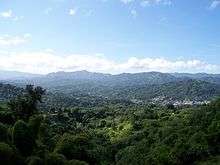
Utuado has regained some of its coffee producing power and was the 3rd largest coffee producer in Puerto Rico in the 2002 USDA Agricultural Census. It also produces oranges (ranked 4th), plantains (ranked 6th) and bananas (ranked 9th). It has been successful with livestock inventory ranking 3rd with hives of bees and 13th with pigs. In terms of manufacturing, Utuado has facilities producing textiles, paper and stone.
Business
Utuado today is equipped with a modern and competitive telecommunications infrastructure. Major cell phone companies including Claro and AT&T offer mobile coverage. Liberty Cablevision and DirecTV offer cable and satellite television service, with Spanish and English channels as well as high-speed Internet service.
Government
Like all municipalities in Puerto Rico, Utuado is administered by a mayor. The current mayor is Ernesto Irizarry Salvá, from the Popular Democratic Party (PPD). Irizarry was elected at the 2012 general election and reelected the following election.
The city belongs to the Puerto Rico Senatorial district V, which is represented by two Senators. In 2012, Ramón Ruiz and Martín Vargas Morales, from the Popular Democratic Party, were elected as District Senators.[26]
Culture
Baseball
The Montañeses de Utuado (English: Utuado Mountaineers) are a semi-professional baseball team based in Utuado that competes in the Puerto Rico Amateur Baseball Federation's Liga Doble A. The team achieved its first national championship in 1941 under the then Federación Deportiva del Norte (English: Sports Federation of the North) as the Utuado Stars. Their second national championship was in 1970 under the current baseball federation. The team won their third national championship on September 1, 2007 against the Bravos de Cidra (English: Cidra Braves). On September 14, 2014, the Montañeses won their fourth national championship title against the Brujos de Guayama (English: Guayama Warlocks) in a 7-game final.
On May 16, 2019, the Montañeses signed Diamilette Quiles, making her not only the first female to play for the team, but also the first female signed in Béisbol Doble A. Quiles was previously on the roster for the Lobas de Arecibo (English: Arecibo Wolves) in the Puerto Rico Women's Amateur Baseball Federation as well as playing softball for Puerto Rico in the Central American and Pan American Games.
Table tennis
Utuado's table tennis players include sisters Adriana, Melanie, Gabriela and Fabiola Díaz, Brian Afanador (cousin to the Díaz sisters), Daniel González, Richard Pietri, Daniely Ríos and Yomar González, all members of the Águilas de la Montaña Table Tennis Club. Both Brian Afanador and Adriana Diaz, members of the International Table Tennis Federation World HOPES Team, have risen to prominence all over the Caribbean, Latin America and the world in their respective categories. The head coaches of the table tennis athletes are Bladimir Diaz, father of the Díaz sisters, and Eladio Afanador, a high-level performance program coach.
Festivals and events
Utuado celebrates its patron saint festival in September. The Fiestas Patronales de San Miguel Arcangel is a religious and cultural celebration to honor Michael (archangel) and generally features parades, games, artisans, amusement rides, regional food, and live entertainment.[10]
Other festivals and events celebrated in Utuado include:
- National BBQ Festival - Originated by locals Samuel Kanig and Ramon G. Garcia, it is a one-day barbecue festival held on the first Sunday of January. It is an annual family event where people exhibit their own creativity by building unique barbecues made from common and uncommon household items. The festival has exhibited barbecue grills made from items such as a toolbox, coffin, light post and even an automobile.
- Juan Domingo Reyes Negrón Bike Day of Friendship - An annual bike day celebrated since 2001, between February and March. Celebrated in memory of Juan Domingo Reyes Negrón, a boy who died in a truck impact while on his bicycle in 2000, the idea was originated by the First Lady, Ivelisse Reyes and Director of the Municipal Office of Recreation and Sports at the time, José F. Collazo, it has since been sponsored by the Municipal Government of Utuado and the Municipal Office of Recreation and Sports.
- Barrio Ángeles Fiesta - April
- Tierra Adentro Festival - Hosted annually by the Agricultural Technology department of the University of Puerto Rico at Utuado, featuring arts and crafts by local artisans, cultural music, food and plant and animal exhibitions. This festival is held in April from a Wednesday to Sunday.
- Guarionex Fiestas - April
- Ángeles Artisanal Fair - An annual arts & crafts fair held in early May in Ángeles barrio featuring local artisans, music and food.
- Rosary Cross - May
- Longaniza Festival - Celebrated its first year in June 2009, it was the lifelong dream of Don Jose A. Carmona "Don Toño" to establish it to celebrate his legacy with his children (his own recipe for seasoning the sausage) and bring another special celebration to the mountain town and celebrate the longaniza.
- Otoao Cultural Festical - An annual cultural event held in the beginning of December celebrating Utuado's Taino heritage.
Transportation
With the recent completion of Highway 10, Utuado has become one of the easiest towns in the interior mountainous region to reach from the San Juan metropolitan area. What used to be a 3-hour trip has been reduced to 1 hour and 30 minutes (to reach the central town). There are 64 bridges in Utuado.[27]
Symbols
Flag

The flag of Utuado was adopted in 1987, under the incumbency of Mayor Waldemar Quiles. It consists of three colored stripes, green, brown and blue laid across; green for the mountains of the town, brown for the fertile soils and blue for the many rivers across the municipality. Centered in the flag is the sun of Otoao, a Taíno representation of the sun.
Coat of arms
The main figure of the shield is a Cemí pierced by a sword. The color of the cemí alludes to the color of the earth, while the silver sword with a hilt in gold recalls San Miguel Arcángel, the town's patron. On the other hand, the Taíno mythological figure that appears on the upper left side symbolizes the "Caguana woman" symbol of fertility for the Taínos. The mine, the peak and the gold shovel crossed by the lamp of the copper miners establish the mineral wealth of this area. Finally, the blue background of the shield remembers its skies, while the lower white stripe alludes to the Viví river that crosses the town.
Anthem
The anthem of Utuado was composed and written by Amílcar Rivera Díaz.
Education
There are currently 20 schools under the Puerto Rico Department of Education system, 2 private schools and one college level institution; the vast majority of children in Utuado attend public schools. The main primary-level education institutions include María Libertad Gómez, Bernardo González, and Judith A. Vivas, among others located outside Utuado Pueblo. Among the principal secondary-level institutions are the Francisco Ramos Middle School, Luis Muñoz Rivera High School and Antonio Reyes Padilla Vocational High School. While most students attend the before-mentioned schools, Utuado also has two private education institutions, both primary-level: Colegio Utuadeño San José and Academia Dailén. Founded in 1979, the University of Puerto Rico at Utuado is the youngest campus of the University of Puerto Rico and the only post secondary-level institution in Utuado, specializing in agricultural studies in areas such as pest control, horticulture, livestock industry and agricultural production.
Notable people
- Brian Afanador, table tennis athlete and Olympian, cousin to sisters Adriana and Melanie Díaz
- Roberto Cortés, Telemundo Puerto Rico weather anchor
- Adriana and Melanie Díaz, table tennis athletes and Olympians, cousins to Brian Afanador
- PFC Fernando Luis García, US Marine private, killed in action in 1952 during the Korean War
- María Libertad Gómez Garriga, educator and politician
- Major Fernando L. Ribas Dominicci, US Air Force pilot, killed in action during Operation El Dorado Canyon
- Marisol Malaret, Miss Puerto Rico 1970 and Miss Universe 1970
- Nuria Sebazco, Telemundo Puerto Rico news reporter
- Ramona Trinidad Iglesias (1889–2004), world’s oldest person and the last person born in 1889, she was 114 years and 272 days old[28][29][30]
- Normando Valentín, WAPA-TV news reporter, anchor and journalist
Gallery
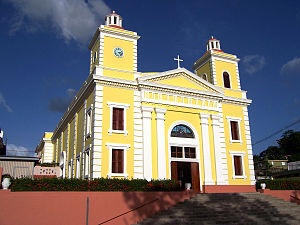 The Church of San Miguel in Utuado
The Church of San Miguel in Utuado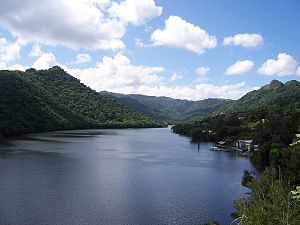 Lago Dos Bocas in Don Alonso barrio
Lago Dos Bocas in Don Alonso barrio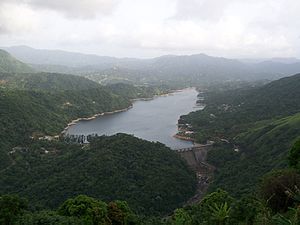 Lago Caonillas in Caonillas barrio
Lago Caonillas in Caonillas barrio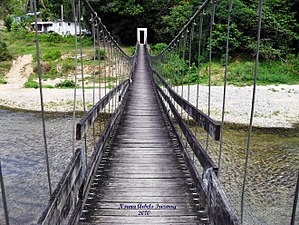 Puente La Hamaca in Utuado
Puente La Hamaca in Utuado
See also
- List of Puerto Ricans
- History of Puerto Rico
- Did you know-Puerto Rico?
- National Register of Historic Places listings in Puerto Rico
References
- "EVACUATION OF PUERTO RICO.; Details Practically Completed -- Lares, Aguadilla, San Sebastian, and Vieques Island to be Given Up Monday". timesmachine nytimes.
- Archivo General de Indias, Reference Code: Ultramar 5147, EXP. 13, Document accessed and viewed at Archivos Españoles en red: www.http://aer.mcu.es/sgae/
- "Historia". Autoridad de Energia Electrica de Puerto Rico (AEEPR). Archived from the original on 2007-03-08. Retrieved 2007-03-05.
- Book: Utuado: Notas Para su Historia, Dr. Pedro H. Hernandez Paralitici, San Juan, 1983, Page 43
- "History of Utuado". Ortizal.com. 2011-11-05. Archived from the original on 2016-04-22. Retrieved 2013-02-18.
- Maria Rosado; Pedro Albizu Campos: Las Llamas de la Aurora; pp. 352, 353; Ediciones Puerto pub.; ISBN 1-933352-62-0
- "Preliminary Locations of Landslide Impacts from Hurricane Maria, Puerto Rico". USGS Landslide Hazards Program. USGS. Archived from the original on 2019-03-03. Retrieved 2019-03-03.
- "Preliminary Locations of Landslide Impacts from Hurricane Maria, Puerto Rico" (PDF). USGS Landslide Hazards Program. USGS. Archived (PDF) from the original on 2019-03-03. Retrieved 2019-03-03.
- https://www.youtube.com/watch?v=aZKDiYCkNd4
- "Utuado Municipality". enciclopediapr.org. Fundación Puertorriqueña de las Humanidades (FPH). Archived from the original on 2017-11-21. Retrieved 2019-03-20.
- Picó, Rafael; Buitrago de Santiago, Zayda; Berrios, Hector H. (1969). Nueva geografía de Puerto Rico: física, económica, y social, por Rafael Picó. Con la colaboración de Zayda Buitrago de Santiago y Héctor H. Berrios. San Juan Editorial Universitaria, Universidad de Puerto Rico,1969. Archived from the original on 2018-12-26. Retrieved 2019-01-01.
- Gwillim Law (20 May 2015). Administrative Subdivisions of Countries: A Comprehensive World Reference, 1900 through 1998. McFarland. p. 300. ISBN 978-1-4766-0447-3. Retrieved 25 December 2018.
- Puerto Rico:2010:population and housing unit counts.pdf (PDF). U.S. Dept. of Commerce Economics and Statistics Administration U.S. Census Bureau. 2010. Archived (PDF) from the original on 2017-02-20. Retrieved 2018-12-26.
- "Map of Utuado at the Wayback Machine" (PDF). Archived from the original (PDF) on 2018-03-24. Retrieved 2018-12-29.
- "US Census Barrio-Pueblo definition". factfinder.com. US Census. Archived from the original on 13 May 2017. Retrieved 5 January 2019.
- "Agencia: Oficina del Coordinador General para el Financiamiento Socioeconómico y la Autogestión (Proposed 2016 Budget)". Puerto Rico Budgets (in Spanish). Retrieved 28 June 2019.
- Rivera Quintero, Marcia (2014), El vuelo de la esperanza: Proyecto de las Comunidades Especiales Puerto Rico, 1997-2004 (first ed.), San Juan, Puerto Rico Fundación Sila M. Calderón, ISBN 978-0-9820806-1-0
- "Leyes del 2001". Lex Juris Puerto Rico (in Spanish). Retrieved 24 June 2020.
- Rivera Quintero, Marcia (2014), El vuelo de la esperanza:Proyecto de las Comunidades Especiales Puerto Rico, 1997-2004 (First ed.), San Juan, Puerto Rico Fundación Sila M. Calderón, p. 273, ISBN 978-0-9820806-1-0
- "Comunidades Especiales de Puerto Rico" (in Spanish). 8 August 2011. Archived from the original on 24 June 2019. Retrieved 24 June 2019.
- "U.S. Decennial Census". United States Census Bureau. Archived from the original on February 13, 2020. Retrieved September 21, 2017.
- "Report of the Census of Porto Rico 1899". War Department Office Director Census of Porto Rico. Archived from the original on July 16, 2017. Retrieved September 21, 2017.
- "Table 3-Population of Municipalities: 1930 1920 and 1910" (PDF). United States Census Bureau. Archived (PDF) from the original on August 17, 2017. Retrieved September 21, 2017.
- "Table 4-Area and Population of Municipalities Urban and Rural: 1930 to 1950" (PDF). United States Census Bureau. Archived (PDF) from the original on August 30, 2015. Retrieved September 21, 2014.
- "Table 2 Population and Housing Units: 1960 to 2000" (PDF). United States Census Bureau. Archived (PDF) from the original on July 24, 2017. Retrieved September 21, 2017.
- "Elecciones Generales 2012: Escrutinio General". CEEPUR. Archived from the original on 2013-01-08. Retrieved 2016-09-15.
- "Utuado". National Bridge Inventory Data. US Dept. of Transportation. Archived from the original on 20 February 2019. Retrieved 19 February 2019.
- "Archived copy". Archived from the original on 2008-11-22. Retrieved 2019-12-02.CS1 maint: archived copy as title (link)
- "Archived copy". Archived from the original on 2019-12-02. Retrieved 2019-12-02.CS1 maint: archived copy as title (link)
- "Archived copy". Archived from the original on 2019-12-02. Retrieved 2019-12-02.CS1 maint: archived copy as title (link)
Further reading
- El Porvenir de Utuado: estudio historico, descriptivo y estadistico, by Ramón Morel Campos, published by El Vapor: Ponce in 1896.
- Libertad y Servidumbre en el Puerto Rico del siglo XIX: (los jornaleros utuadeños en vísperas del auge del café), by Fernando Picó, published by Ediciones Huracan in 1979.
- Los Gallos Peleados, by Fernando Picó, published by Ediciones Huracan in 1983.
- Amargo Café: los pequeños caficultores de Utuado en la segunda mitad del siglo XIX, by Fernando Picó, published by Ediciones Huracan in 1981.
- El Dorado Borincano: La economia de la conquista 1510-1550, Jalil Sued Badillo, published by Ediciones Puerto Rico in 2001.
- Historia Geografica, Civil y Natural de la isla de San Juan Bautista de Puerto Rico, Fray Iñigo Abbad y Lasierra, originally published in 1788, later published in 1866 with annotations by Jose Julian Acosta y Calbo.
External links
| Wikimedia Commons has media related to Utuado, Puerto Rico. |